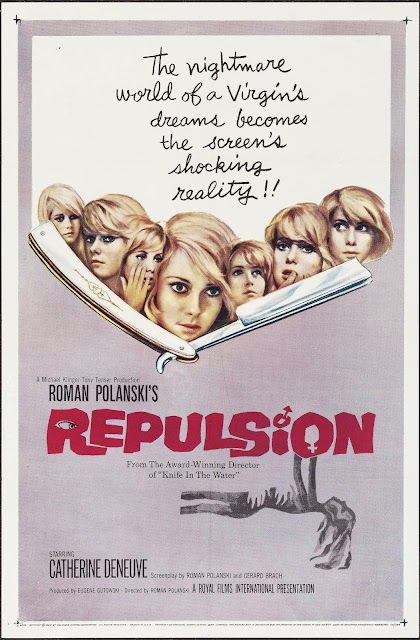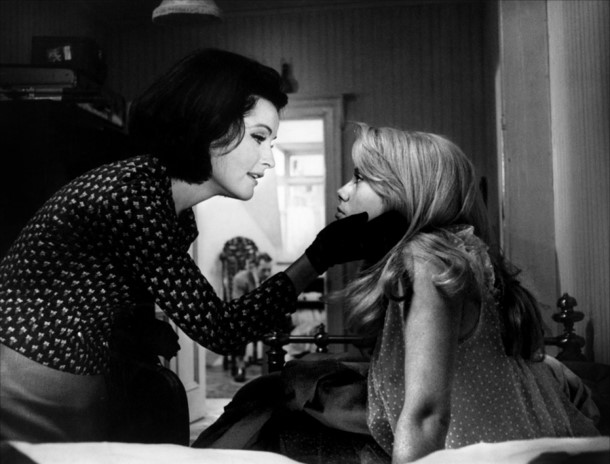'Repulsion' (1965) - Film Review
 |
Figure 1-
Repulsion (1965) [Poster]
|
This
review analyses Roman
Polanski’s British psychological horror film Repulsion (1965), explicitly focusing on the subject of gender specifically
women how they are portrayed through the characters of Carol and Helen within
the film. Referring to the works of Rebecca Cafe’s article on ‘How the
contraceptive pill changed Britain’ looking
at the contraceptive pill and its effect on women in society. (2011), Kenneth
T. Walsh’s writings ‘The 1960s: A
Decade of Change for Women’ (2010) focusing
on how women began to have a new out look on how they should live their life,
Culture’s ‘How The Invention Of The Mini Skirt Shook Up The 1960s’ (2016)
looking at how fashion had a massive impact on women during the 1960s, and Ian
Hendry’s short video documentary ‘Repulsion (1965) | Documentary Short -
Interview w/ Dir. Roman Polanski -Ian Hendry’ (2013) looking into producer
Polanski’s first idea for the leading lady of the film. The review will explain
how the 1960s’ idealised perception of women and their new-found freedom had an
impact of the characters of Carol and Helen within the film ‘Repulsion’ (1965)
and looking at how they indicate different attributes of both 1950s and 1960s societal
perception of women.
Repulsion
(1965) takes place in the 1960s and tells the story of Carol, a young
woman that works at a beauty salon in London. She lives in a flat with her
sister Helen, who dates a married man called Michael. It is clear that Carol
has a hatred towards Michael, which enhances her existing dislike of men. Helen
and Michael decide to go to Spain on a short holiday leaving Carol alone in the
flat. As time goes by Carol slowly descends into madness, having vivid hallucinations
of men that lead to multiple deaths by her own hands.
During
the time that the Repulsion (1965)
was made, the world was going through some ground-breaking changes especially
in the case of women. In 1961, the contraception pill was first introduced to
married women, and it gave women the opportunity to control inevitably their
future in terms of children.
This was
apparent in Britain where, unlike the 1950s, the contraceptive pill gave women
control over their lives in terms of unsuspected pregnancies. It allowed women
not to rely on males for contraception, leading to less marriages. As often
once a woman is pregnant the men would have the obligation to wed, in fear of
having a child out of wedlock. But with
the creation the pill, marriages for women were harder to come by. However, not
all were so keen on the idea of the contraception arguing that it was a form of
abortion. Along with this some people believed that the young people of Britain
would slowly lose the meaning of love, as they would instead give into sexual
desires with women now being able to sleep around. (R. Cafe (2011)).
“One
of the most profound changes was happening in the bedroom. By the end of the
Sixties, more than 80 percent of wives of childbearing age were using
contraception after the federal government in 1960 approved a birth control
pill. This freed many women from unwanted pregnancy and gave them many more
choices, and freedom” (K.T. Walsh. (2010)) With majority of women being on the pill,
ladies were able to become much more sexually promiscuous.
 |
Figure
2- Women of 1960s Britain (1963)
|
Due to
the contraceptive pill being introduced women were given the opportunity to
dress more expressively, with skirts becoming shorter, colours become brighter,
fashion being more outlandish (see fig 2) allowing women to emulate that
freedom of their sexuality. This brought about the popularity of the mini
skirt, which allowed women to embrace their sexuality. (see fig 3)
 |
Figure
3- Miniskirts in 1960s' Britain Culture
|
“The
miniskirt was more than just a skirt that laid a few inches above the
knee, it was symbol of youth, sexuality, and power. At the time young people
were sick of not having their voices heard and having to fit into a certain mould.”
(Culture (2016)) This highlights how repressed women were not only in fashion
but within their role in society. In fact, this would
never have been considered a decade beforehand with fashion being much more
conservative. Women during the 1950s were perceived to be innocent and naïve
around their sexuality (see fig 5) through wearing clothes that would hide the
body being sure to keep the 1950’s lady modest in her attire. (Culture (2016))
 |
Figure
4- 1950s Women’s Fashion
|
When
creating the film, Polanski worked with the idea of an innocent sexually naïve woman,
in an interview on the concept of Repulsion
(1965) Polanski recalled “We knew a girl in San Jama… was quite innocent, young
and delicate, looked very sweet. One of
my friends started dating this girl and was telling us that he was discovering
an entirely different side of this girl, there was a great surprise to us” (I.
Hendry (2013)) This source of inspiration for the film is clearly illustrated in
Polanski’s female lead Carol, who is viewed as being beautiful and innocent yet
timid to males, along with her hidden dark side. This dynamic of Carols innocence can
be shown with her sister, Helen, acting as her motherly figure throughout the
film, always tending to Carols needs (see fig 5)
 |
Figure
5- Carol and Helen Repulsion (1965)
|
“She
is an arrested adolescent who, like an anorexic, cannot face her womanliness
without visions of perverse opulence and violence”. (K. Morgan (2009)) It can
be argued that Carol showcases both old and new ideologies of societal norms of
women around that time period, which then contrasts to her sister.
Throughout
the duration of the film, Helen on multiple occasions is objectified
by men. An example of this is when she gets thrown around by her lover Michael
and slapped upon finding a dead body in the apartment, as if it was acceptable
to be treated like that.
 |
Figure
6- Helen being obedient to Michael Repulsion
(1965)
|
Helen is
also known to follow the orders of all other male characters, including Michael
who in one scene ask her to dress pretty for him “Go put your best bib and
tucker on I feel like a spree” Michael (1965). Not only is this objectifying her, by treating her
like a possession but it is also highlighting the fact that she is sexualised
and will still however be obedient to his wishes. (see fig 6)
Helen
also complies to the 1950s’ role of women by still remaining a stay at home
woman who cooks and cleans for the household which is shown in multiple scenes
where she tries cooking the rabbit that is later shown within the film,
decaying and rotting due to time passing and Carol not getting rid of it.
However, although
Helen may lack freedom around men in regard to what they instruct her to do,
she is still liberated through her freedom around sex. Not only is she heard at
multiple points within the film to be taking part in sexual activity, but she
is also shown wearing short, revealing outfits
within the film like the 1960s attire (see fig 7) Unlike her sister. (also
shown in the photo)
 |
Figure
7- Helen in revealing attire
|
Carol is opposite
to Helen, both in terms of appearance and personality. Carol dresses very conservatively
like that of 1950s’ women (see fig 7), while also struggling to adhere to the
new sexual freedom that women now have, which is shown through her reactions revolving
around sex and men.
Carol is
seen within the film, like to her sister to be objectified by men. An instance
of this happening is during the opening scene, in which the worker men look her
up and down as a sexualized object (see fig 8).
 |
Figure
8- Males watching Carol (1965)
|
However,
she still manages to avoid following males’ instructions and objectifications
and does as she pleases, this is shown in a multitude of ways. For example, she
avoids going on a date with Colin who insists they go together (see fig 9), in
the end resulting in his murder.
 |
Figure
9- Carol not giving in to Colin Repulsion
(1965)
|
“(Carol)
what lies beneath the “perfect woman,” she is the reflection of what lies
beneath repressed desire” (K. Morgan. (2009)) This argues that although she is
seen to hate men and sex, instead she is rather envious of it, or even her
sister and how she is able to flaunt her sexual promiscuity, which would have
been held back in the 1950s.
In
conclusion, at the time of Repulsion (1965)
being released, women were going through some big changes, that allowed them to
have a lot more freedom than they had a decade before. However, some could not
agree with how females were taking more control of their new-found freedom,
which can be arguably depicted within the film with Carol representing the 1950s’
view point of women and Helen illustrating the new 1960s’ view.
Harvard
Illustrations List
Figure 1-
Repulsion (1965) [Poster] Film/Art
Gallery. (1965). Repulsion. Available: https://filmartgallery.com/products/repulsion-8054
Last accessed 24/11/2018.
Figure
2- Women of 1960s Britain (1963) -
M. Rawi. (2012). What a difference a decade makes: The fashion images
that show how British women moved out of the 1950s and into the Swinging
Sixties. Available: https://www.dailymail.co.uk/femail/article-2088993/What-difference-decade-makes-The-fashion-images-British-women-moved-1950s-Swinging-Sixties.html Last accessed 22/11/2018.
Figure 3-
Miniskirts in 1960s Britain Culture. (2016). How The Invention Of The
Mini Skirt Shook Up The 1960s. Available: http://groovyhistory.com/how-the-invention-of-the-mini-skirt-shook-up-the-1960s/1
Last accessed 22/11/2018.
Figure 4-
1950s Women’s Fashion - C. Leaper. (2017). The biggest 1950s fashion
style moments that defined the decade Read more at
https://www.marieclaire.co.uk/fashion/1950s-fashion-icons-fifties-style-moments-in-pictures-81397#7xHvxbJYTMxkpTM4.99. Available:
https://www.marieclaire.co.uk/fashion/1950s-fashion-icons-fifties-style-moments-in-pictures-81397 Last accessed 22/11/2018.
Figure 5-
Carol and Helen Repulsion (1965) - Alum
Media Ltd.. (N/A). Yvonne Fumeaux and Catherine Deneuve in Repulsion
directed by Roman Polanski, 1965. Available: https://flashbak.com/lower-east-upper-west-new-york-city-street-photographs-jonathan-brand-1957-1968-396229/yvonne-fumeaux-and-catherine-deneuve-in-repulsion-directed-by-roman-polanski-1965/
Last accessed 22/11/2018.
Figure 6-
Helen being obedient to Michael Repulsion
(1965) N. Hendry. (2015). Repulsion (1965) 50th Anniversary – Part
2 – Catherine Deneuve + Ian Hendry + John Fraser + Yvonne Furneaux (dir. Roman
Polanski). Available: https://ianhendry.com/repulsion-1965-50th-anniversary-part-2-catherine-deneuve-ian-hendry-john-fraser-yvonne-furneaux-dir-roman-polanski/ Last accessed 22/11/2018.
Figure
7- Helen in revealing attire chained
and perfumed. (1965). Repulsion. Available: https://chainedandperfumed.com/2012/12/03/repulsion-2/
Last accessed 25/11/2018.
Figure 8-
Males watching Carol (1965) J. Ipcar. (2013). Repulsion at Catherine
Deneuve and Roman Polanski. Available: http://www.back-row.com/home/2018/3/7/repulsion-at-catherine-deneuve-and-roman-polanski
Last accessed 22/11/2018.
Figure 9-
Carol not giving in to Colin Repulsion (1965)
- Deutsche Kinemathek. (2010). Repulsion. Available: https://www.berlinale.de/en/archiv/jahresarchive/2010/02_programm_2010/02_Filmdatenblatt_2010_20106414.html#tab=filmStills Last accessed 22/11/2018.
Bibliography
BBC
Bitesize. (2008). The changing
role of women in the 1960s.Available: https://www.bbc.com/bitesize/clips/zr37pv4
Last accessed 22/11/2018.
Culture.
(2016). How The Invention Of The Mini Skirt Shook Up The 1960s. Available:
http://groovyhistory.com/how-the-invention-of-the-mini-skirt-shook-up-the-1960s/
Last accessed 22/11/2018
Delproductions.
(2013). GENDER REPRESENTATION IN
THE THRILLER GENRE- FEMALES. Available: https://delproductions.wordpress.com/2013/11/20/gender-representation-in-the-thriller-genre-females/ Last accessed 22/11/2018.
E. Moore.
(2016). Sexual Violence and
Female Experience in Roman Polanski’s Apartment Trilogy: Repulsion, Rosemary’s
Baby, The Tenant. Available: https://brightlightsfilm.com/wp-content/cache/all/sexual-violence-female-experience-roman-polanskis-apartment-trilogy-repulsion-rosemarys-baby-tenant/#.W_ZjnDj7TIU Last accessed 22/11/2018.
G.
Cileone. (2015). Repulsion. Available:http://mymeaningfulmovies.blogspot.com/2015/08/repulsion.html
Last accessed 22/11/2018.
G. Cwik.
(2015). 50 years ago, Repulsion
pioneered a new genre of gendered horror. Available: https://film.avclub.com/50-years-ago-repulsion-pioneered-a-new-genre-of-gender-1798285951
Last accessed 22/11/2018.
I.
Hendry. (2013). Repulsion (1965) | Documentary
Short - Interview w/ Dir. Roman Polanski -Ian Hendry. Available:
https://www.youtube.com/watch?v=nGISoIwm3Mw
Last accessed 22/11/2018.
K.
Hagen. (2016). 31 Days of
Feminist Horror Films: ROSEMARY’S BABY + REPULSION. Available: https://blog.blcklst.com/31-days-of-feminist-horror-films-rosemarys-baby-repulsion-156ebb671c81 Last accessed 22/11/2018.
K.
Morgan. (2009). Roman Polanski Understands Women: Repulsion.
Available: https://www.huffingtonpost.com/kim-morgan/roman-polanski-understand_b_301292.html?guccounter=1
Last accessed 22/11/2018.
K.
Watson. (2016). The 1960s The Decade that Shook Britain. Available:
https://www.historic-uk.com/CultureUK/The-1960s-The-Decade-that-Shook-Britain/
Last accessed 22/11/2018.
K.T.
Walsh. (2010). The 1960s: A Decade of Change for Women. Available: https://www.usnews.com/news/articles/2010/03/12/the-1960s-a-decade-of-change-for-women Last accessed 22/11/2018.
M. Rawi.
(2012). What a difference a decade makes: The fashion images that show
how British women moved out of the 1950s and into the Swinging Sixties. Available:
https://www.dailymail.co.uk/femail/article-2088993/What-difference-decade-makes-The-fashion-images-British-women-moved-1950s-Swinging-Sixties.html
Last accessed 22/11/2018
R. Cafe.
(2011). How the contraceptive pill changed Britain. Available:
https://www.bbc.co.uk/news/uk-15984258
Last accessed 25/11/2018.


Well researched and contextualised Shannon :)
ReplyDelete